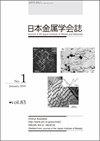Effect of Ions Eluted from Metal Surface on Transformation and Growth of Calcium Carbonate Polymorphisms
IF 0.4
4区 材料科学
Q4 METALLURGY & METALLURGICAL ENGINEERING
引用次数: 1
Abstract
The amounts of calcium carbonate adhered on sheets (PVC, carbon steel, Type 316 stainless steel, and Cu) and coated steels sheets (Cu, Zn, Ni, Ni–P, and Ni–W–P coated steels) were investigated in the synthesis solution. The transformation and crystal growth of the calcium carbonate were different among the materials. The primary form in the adhered polymorphisms was calcite on PVC, carbon steel, Type 316 stainless steel, Cu, and Cu coated steel, and aragonite on Zn, Ni, Ni–P, and Ni–W–P coated steels, and vaterite was not primary form on all materials. The materials, on which the primary form in the adhesion polymorphisms is calcite, showed large adhesion amounts because calcite is stable phase and its solubility is lower than the other polymorphisms. The crystal growths of the specific polymorphisms on some materials were inhibited, and the irregular shapes of their polymorphisms formed: calcite adhered on carbon steel and Ni, Ni–P, Ni–W–P coated steels, aragonite adhered on Zn, Ni–P, and Ni–W–P coated steels became the irregular shape. The comprised elements of the material surfaces were detected at the surface of the calcium carbonate crystals adhered on the materials. The transformation and crystal growth are affected by the elution ions from the material surfaces, and the effects of eluted ions (Fe2+, Cu2+, Zn2+, Ni2+, and PO4) from these materials were almost same with the ones of previous studies. To reduce the adhesion amount of calcium carbonate, the material comprised of the elements, which shows the inhibitor effects of the transformation and the crystal growths of many kinds of polymorphisms, is better. [doi:10.2320/ jinstmet.J2016045]金属表面离子洗脱对碳酸钙相变和生长的影响
在合成溶液中考察了碳酸钙在板材(PVC、碳钢、316型不锈钢和Cu)和涂层钢板(Cu、Zn、Ni、Ni - p和Ni - w - p涂层钢)上的粘附量。不同材料的碳酸钙的相变和晶体生长不同。在PVC、碳钢、316型不锈钢、Cu和Cu涂层钢上的主要形态是方解石,在Zn、Ni、Ni - p和Ni - w - p涂层钢上的主要形态是文石,而不是所有材料上的主要形态都是水晶石。由于方解石是稳定相,其溶解度低于其他形态,因此以方解石为主的材料表现出较大的粘附量。某些材料上特定晶型的晶体生长受到抑制,晶型形成不规则形状:方解石附着在碳钢和Ni、Ni - p、Ni - w - p涂层钢上,文石附着在Zn、Ni - p和Ni - w - p涂层钢上,形成不规则形状。在附着在材料上的碳酸钙晶体表面检测材料表面的组成元素。材料表面的洗脱离子影响了晶体的转变和生长,洗脱离子(Fe2+, Cu2+, Zn2+, Ni2+, PO4)对材料的影响与前人的研究结果基本相同。为了降低碳酸钙的附着量,元素组成的材料表现出抑制多种晶型转变和晶体生长的效果较好。(doi: 10.2320 / jinstmet。J2016045]
本文章由计算机程序翻译,如有差异,请以英文原文为准。
求助全文
约1分钟内获得全文
求助全文
来源期刊

Journal of The Japan Institute of Metals
工程技术-冶金工程
CiteScore
0.70
自引率
0.00%
发文量
27
审稿时长
6-12 weeks
期刊介绍:
Information not localized
 求助内容:
求助内容: 应助结果提醒方式:
应助结果提醒方式:


